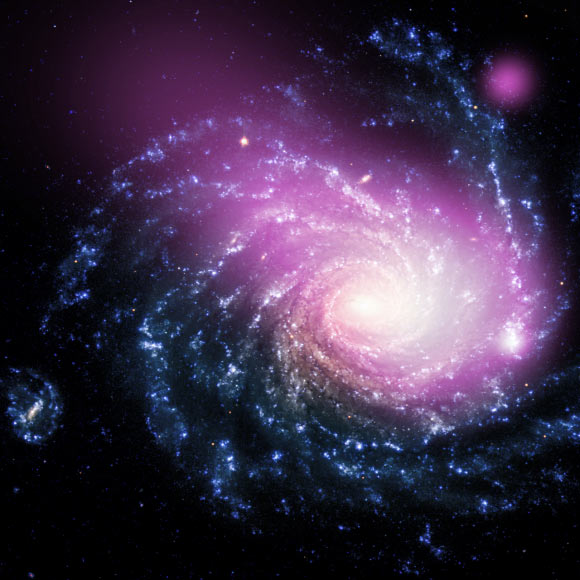U.S. astronomer using NASA’s Chandra X-ray Observatory has discovered a massive cloud of hot gas likely caused by a collision between a dwarf galaxy and the much larger galaxy NGC 1232.

X-ray data, in purple, show the hot gas has a comet-like appearance, caused by the motion of the dwarf galaxy. Optical data reveal the spiral galaxy NGC 1232 in blue and white (X-ray: NASA / CXC / Huntingdon Inst. for X-ray Astronomy / G. Garmire; optical: ESO / VLT).
The intermediate spiral galaxy NGC 1232 is located in the constellation Eridanus about 60 million light-years away.
Dr Gordon Garmire from the Huntingdon Institute for X-ray Astronomy, who is an author of the paper published in the Astrophysical Journal (preprint at arXiv.org), has detected an unusual, comet-shaped X-ray emission from hot gas in NGC 1232.
Near the head of the X-ray emission is a region containing several very optically bright stars. Star formation may have been triggered by the shock wave, producing bright, massive stars. In that case X-ray emission would be generated by massive star winds and by the remains of supernova explosions as massive stars evolve.
The mass of the entire gas cloud is uncertain because it cannot be determined from the two-dimensional image whether the hot gas is concentrated in a thin pancake or distributed over a large, spherical region.
If the gas is a pancake, the mass is equivalent to forty thousand Suns. If it is spread out uniformly, the mass could be much larger, about three million times as massive as the Sun.
The hot gas should continue to glow in X-rays for tens to hundreds of millions of years, depending on the geometry of the collision. The collision itself should last for about 50 million years.
An alternative explanation of the X-ray emission is that the hot gas cloud could have been produced by supernovas and hot winds from large numbers of massive stars, all located on one side of the galaxy. The lack of evidence of expected radio, infrared, or optical features argues against this possibility.
If confirmed, the discovery would mark the first time such a collision has been detected only in X-rays, and could have implications for understanding how galaxies grow through similar collisions.
______
Bibliographic information: Gordon P. Garmire. 2013. X-Ray Discovery of a Dwarf-galaxy-Galaxy Collision. ApJ 770, 17; doi: 10.1088/0004-637X/770/1/17







